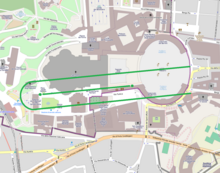Circus of Nero
Circus |

The so-called Circus of Nero or Circus of Caligula was a
It was first built under Caligula.
History
The Ager Vaticanus, the alluvial plain outside the city walls on the west bank of the Tiber, was developed at the end of the first century BC,[2] allowing patrician families to construct luxurious private residences (Horti).[3] The Horti Agrippinae villa-estate belonged to Agrippina the Elder and was inherited by her son Caligula (r. 31–41 AD). He was a chariot-racing enthusiast and began construction of the circus which was completed by Claudius (r. 41-54 AD).
The privately owned circus and Horti were then inherited by Nero who made the circus public so he could invite them to cheer him on.[4] He also used both of these to lodge Romans made homeless by the great fire of 64. The circus was used in 65 to carry out mass executions of the Christians accused as scapegoats of the fire itself.[5] Because of this the area beyond the Tiber north of Trastevere was known as "Nero's meadows" until the end of the Middle Ages.[6]
The circus was also the site of St. Peter’s and St. Paul’s martyrdom.
The circus was abandoned by the middle of the second century AD, when the area was partitioned and given in concession to private individuals for the construction of tombs in the necropolis.
Place of martyrdom
The circus was the site of the first organized, state-sponsored
The site for crucifixions in the Circus would have been along the
Nearby Roman cemetery
The
- On that day, I entered a square sepulchral room the ceiling of which was ornamented with designs in painted stucco. There was a medallion in the centre, with a figure in high relief. The door opened on the Via Cornelia, which was on the same level. This tomb is located under the seventh step in front of the middle door of the church. I am told that the sarcophagus now used as a fountain, in the court of the Swiss Guards, was discovered at the time of Gregory XIIIin the same place, and that it contained the body of a pagan.
See also
- Circus Maximus
- Index of Vatican City-related articles
References
- ^ Based on "Outline of St. Peter's, Old St. Peter's, and Circus of Nero".
- ISBN 978-88-04-11896-1p 311
- ISBN 978-88-492-3320-9p 21
- ^ Tacitus, Annals 14.14.4
- ISBN 978-88-492-3320-9p 23
- ^ Castagnoli, Ferdinando; Cecchelli, Carlo; Giovannoni, Gustavo; Zocca, Mario (1958). Topografia e urbanistica di Roma. Bologna: Cappelli. p. 239
External links
- stpetersbasilica.info - Largest online source of information on St. Peter's Basilica and Square in the Vatican City.
- Lacus Curtius website: Circus of Nero, plan superposed with the Basilicas, showing the tomb of Peter, and text by Rodolfo Lanciani describing the largely inadvertent archaeology.
- Lucentini, M. (31 December 2012). The Rome Guide: Step by Step through History's Greatest City. Interlink. ISBN 9781623710088.
![]() Media related to Circus of Nero (Rome) at Wikimedia Commons
Media related to Circus of Nero (Rome) at Wikimedia Commons
| Preceded by Circus of Maxentius |
Landmarks of Rome Circus of Nero |
Succeeded by Colosseum |
